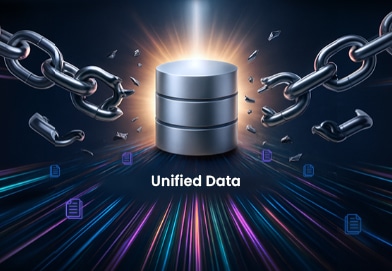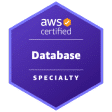Most data initiatives fail because they start with tools, not strategy. According to a 2023 NewVantage Partners survey, only 24% of organizations consider themselves data-driven, and over 90% cite cultural and organizational challenges, rather than technological ones, as primary barriers.
Without clear data strategy alignment, companies risk misaligned efforts, wasted resources, and missed opportunities. A data strategy serves as an organizational blueprint, defining how data will tie to enterprise objectives, create value, and ensure proper, legally compliant use.
In contrast, data management focuses on how organizations maintain, secure, and store data. For executive leaders, the message is clear: strategy must come first. Without it, data management risks becoming an isolated exercise that won’t deliver meaningful return on investment (ROI).
Understanding Data Strategy and Data Management
To ensure effective data strategy alignment with business goals, leaders must understand the difference between data strategy and data management. While the two are deeply connected, they aren’t interchangeable.
A data strategy is an organization’s detailed plan that aligns how it collects, manages, and utilizes data to achieve its goals. It’s the executive blueprint that guides decision-makers on how to leverage data as an asset, ensuring actionable data initiatives that drive business value.

On the other hand, data management refers to the policies, operational processes, and technologies that organizations use to gather, store, protect, and deliver data. It focuses on how organizations handle data securely and efficiently on a daily basis to ensure accessibility, reliability, and regulatory compliance.
Without data strategy, management becomes reactive and fragmented. Without management, the strategy cannot be executed. However, the order also matters since strategy aligns data to business value while management brings the strategy to life.
Differences Between Data Strategy and Data Management
| Aspect | Data Strategy | Data Management |
| Primary Focus | Value creation and business alignment | Operational control and data lifecycle execution |
| Purpose | Define goals, priorities, and use cases for data | Implement policies, systems, and governance |
| Time Frame | Long-term, forward-looking | Ongoing, short- to mid-term operations |
| Scope | Enterprise-wide, cross-functional | Departmental or function-specific |
| Tools | Frameworks, roadmaps | ETL pipelines, data catalogs, MDM, governance tools |
Before diving into the roadmap, it’s crucial to understand the differences between data strategy and data management. While a data strategy defines the “why” and “what”, data management deals with the “how”. Here’s a detailed breakdown of their crucial differences.
Primary Focus
The main focus of a data strategy is business growth and innovation. It sets the business direction by deciding the goals an organization can achieve with data and where to focus its efforts to create value. Conversely, data management focuses on executing the day-to-day processes that keep the data compliant, consistent, secure, and accessible.
Purpose
The primary goal of a data strategy is to define how data can support a business. It helps define the priorities, sets the tone for how data is used, and identifies key projects. Alternatively, data management deals with the execution of these tasks. That’s by providing consistent, reliable data to support the strategic operational goals.
Time Frame
Data strategy focuses on the long term. It sets future agendas based on where a business wants to go and how data can help it get there. However, data management focuses on the ongoing processes and tasks. This helps ensure that data flows smoothly within an organization daily while ensuring its accuracy and security.
Scope
A data strategy covers an entire business. This is a company-wide effort that connects different departments and teams to create a shared vision for data. That said, data management takes place at a more granular level. This helps ensure that every part of an organization manages its data effectively.
Tools
When working on a data strategy, decision-makers and leaders use models and frameworks to better understand how data can create value. After this, they can create roadmaps to outline the business journey. Meanwhile, data management relies on more technical systems and tools. These tools handle actual data organization, processing, and governance.
Why Data Strategy Comes Before Data Management
For data-driven organizations, the order of operations matters. Starting with data management might seem logical; however, without a defined data strategy, these actions lack context. Organizations end up maintaining systems that don’t support their objectives, wasting resources and time.
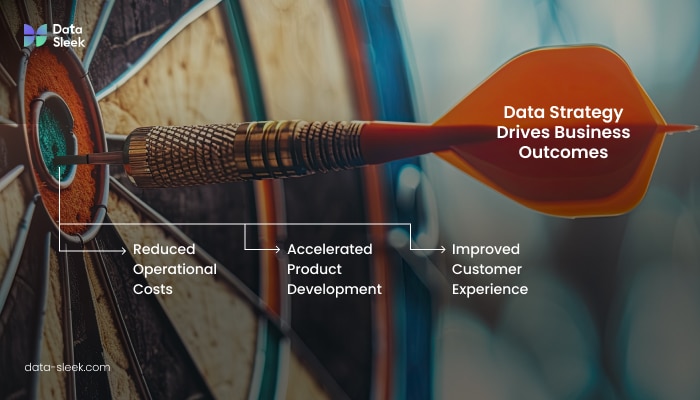
A strong data strategy sets the “why” behind every data activity. It outlines goals, prioritizes initiatives, and defines data usage permissions. Only then can management implement processes, tools, and policies that drive value.
How to Align Data with Business Goals
Before investing in processes or platforms, business leaders must define the value that data is meant to deliver. A clear data strategy links every initiative, be it analytics, governance, or architecture, to specific business outcomes. Without this alignment, data management efforts end up siloed, reactive, and expensive, often generating insights that don’t move the needle.
A strong data strategy answers foundational business questions before any tools are deployed:
- What outcomes are we trying to achieve?
- Customer insight, growth, efficiency, or innovation. Each outcome demands different data priorities.
- Which use cases will move the needle?
- Having strategic clarity helps understand that not all data projects are equal. It also helps separate high-impact opportunities from noise.
- Who needs access, and under what conditions?
- Alignment helps define user permissions, roles, and responsibilities early thus avoiding risk of exposures or future bottlenecks.
- What does success look like?
- By defining key performance indicators (KPIs) upfront, data teams can measure value, adjust direction, and earn executive trust.
The Data Strategy Roadmap
For executive leadership, a successful data strategy must have clear, progressive stages to ensure that organizations build capabilities in the right order. Here’s a clear roadmap that breaks down the essential stages every company should consider to turn data from a raw resource into a strategic asset that results in measurable business value.
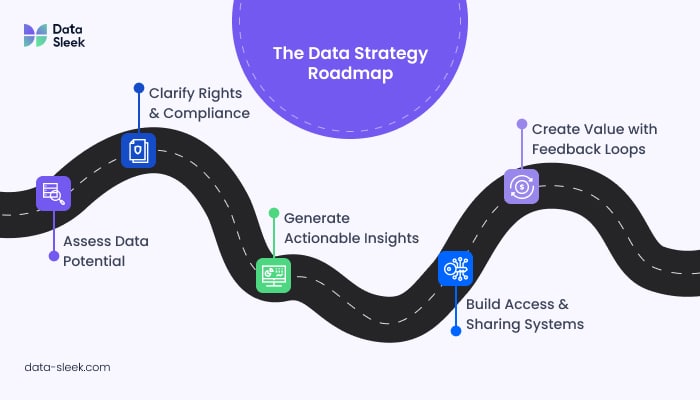
1. Assess Data Potential
Before investing in tools or data lakes, leaders must assess how data ties directly to business value. It starts by mapping out the types of data the company can access, like customer data, third-party sources, and internal operations.
This assessment should surface key business questions that data can answer, such as optimizing supply chains or improving customer retention. It should also help identify any risks, limitations, or blind spots in data accessibility, coverage, or compliance exposure.
2. Clarify Legal, Ethical, and Contractual Use Rights
Without clear guidelines on what data an organization can use and how, even the most promising initiatives can backfire. Leaders must engage legal and compliance teams early to help review the rights and conditions under which data is collected.
This can help clarify whether customer data can be repurposed for marketing or even whether there are clauses limiting data sharing with vendors. In addition, ethical considerations also matter, ensuring the company uses data responsibly, even when legally allowed. This maintains trust with customers and regulators alike.
3. Define Strategic Use Cases
A successful data strategy must be grounded in business impact. Executive teams should collaborate with domain leads to define a set of strategic use cases tied to cost savings, revenue growth, or improved risk management. These use cases need prioritization, since not everything can be tackled at once. Therefore, they should outline:
- The process or decision that the data will improve
- The data needed to enable the change
- How success will be measured
4. Building Data Access and Sharing Capabilities
Value from data comes from centralization and activation. Therefore, business teams must timely secure access to the data and relevant insights. This requires implementing governed self-service tools, breaking down silos, and defining access policies based on business roles. Democratizing data in a way that balances agility with accountability ensures that data becomes a strategic asset across marketing, product, compliance, and operations.
5. Create Continuous Value Through Feedback Loops
Data strategy requires iteration. As the business conditions change and new data becomes available, leaders must revisit strategic use cases and assess performance. It helps understand what worked, what didn’t, and the barriers. Having regular review cycles and clear feedback channels between data teams and business units can help refine access, infrastructure, and governance.
This continuous optimization keeps the data strategy aligned with evolving organizational goals. It also turns data into a tool for innovation and sustained competitive advantage.
Clarifying Data Use Rights Early
Overlooking data use rights during strategic planning has serious consequences, including costly regulatory exposure, delayed product launches, and friction between teams. As organizations increasingly analyze and share data across vendors and departments, legal ambiguity becomes a barrier to agility.
To avoid these pitfalls, data leaders should embed legal and compliance input into the data strategy roadmap. It ensures clarity around:
- Data ownership and access: Who controls data, and who can use it?
- Consent and usage rights: Who is authorized to process and share the data, especially in analytics and AI?
- Third-party agreements: Do contracts address downstream data rights, accountability, and breaches?
- Jurisdictional compliance: Is the organization meeting regional requirements like HIPAA or GDPR?
Example: In November 2019, Ascension, one of the largest U.S. health systems, quietly shared the full medical records of up to 50 million patients with Google Cloud under the “Project Nightingale” initiative, without alerting patients or doctors. This raised concerns about unauthorized secondary use of data. Despite invoking a HIPAA-compliant business associate agreement, at least 150 Google employees reportedly accessed identifiable health data, triggering a federal investigation by HHS’s Office for Civil Rights.
This case shows that even legally sanctioned data-sharing can be halted or tarnished if secondary-use terms aren’t clearly communicated, legally vetted, and transparently disclosed at the outset.
How Data Strategy Drives Business Outcomes
A well-crafted data strategy not only manages information but also powers a company’s ability to achieve its objectives. Whether reducing operational costs, accelerating product development, or improving customer experience, a data strategy combines these ambitions with concrete data use cases. Here are more ways in which data strategy drives business outcomes.
Prioritizes High-ROI Data Initiatives
A strong data strategy guides an organization to focus on data initiatives that directly impact cost reduction, revenue growth, operational efficiency, and regulatory compliance. It offers a structured method to assess each initiative’s potential and filters out misaligned or low-impact efforts.
This allows an organization to prioritize high-impact initiatives, ensuring limited resources are only used where they matter most. It helps avoid wasted efforts on low-value initiatives, which could create a fragmented data ecosystem.
Connects Use Cases to Business Objectives
A data strategy spells out how data is used to meet an organization’s needs. It translates the enterprise objectives into targeted data use cases. Within a growth-focused company, the strategy might prioritize dynamic pricing models or better customer segmentations.
For an organization focused on cost containment, it could center on reducing procurement waste or optimizing logistics. These use cases give organizations a measurable bridge between the data program and real-world business needs. It also ensures that investments are purposeful and outcome-oriented.
Creates ROI-Driven Decision Loops
Well-executed data strategies define success metrics at the outset. These may include faster decision cycles, productivity gains, improvements in customer lifetime value, or reduced operational risks. These metrics act as the foundation for making continuous improvements and tracking ROI.
By continuously measuring and reporting the outcomes, an organization closes the loop between strategy, execution, and business value. This feedback cycle builds executive confidence, reinforces a culture of data as a strategic asset, and accelerates decision-making.
Real-World Data Strategy vs Data Management Errors
Even well-resourced organizations can make the mistake of jumping into execution before creating a strategy. Here are the most common errors organizations make when confusing data management with data strategy.
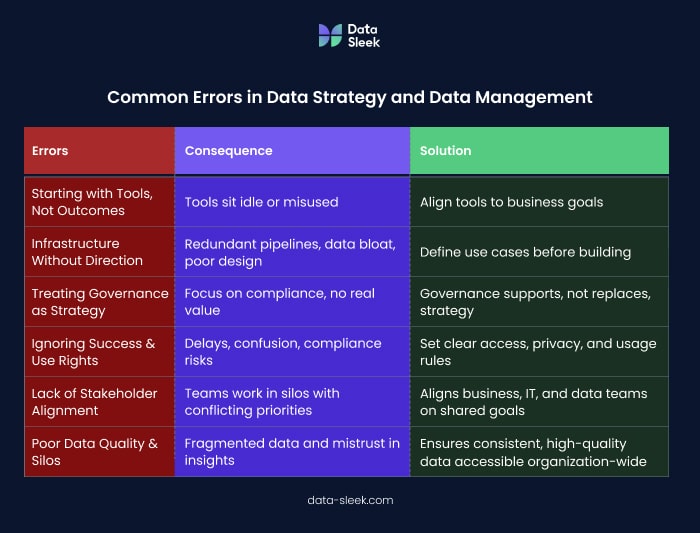
Starting with Tools, Not Outcomes
Some organizations kick off their data journey by investing in technologies and tools like Snowflake, Tableau, Looker, and dbt. However, these tools end up generating low-impact reports or sitting idle since the businesses don’t know what they need to solve. Without a data strategy in place to lay out the business objectives, the tool ends up a silo instead of a solution.
Building Infrastructure Without Direction
At times, IT teams could push for integration pipelines or centralized data warehouses before understanding the necessary data and how to use it. Such an approach results in redundant pipelines, data bloat, or even misaligned architecture. Implementing the right sequence helps define the use cases, which allows for the proper infrastructure design.
Treating Governance as a Strategy
Data governance is essential, but it is not a substitute for a data strategy. Some organizations mistakenly believe that implementing governance frameworks alone means they have a strategy. In reality, governance focuses on enforcing policies, ensuring data quality, and managing compliance and risk. It provides accountability and oversight mechanisms that support the broader strategic vision. In other words, governance is how the strategy is operationalized and kept on track. It supports, but does not replace, the strategy itself.
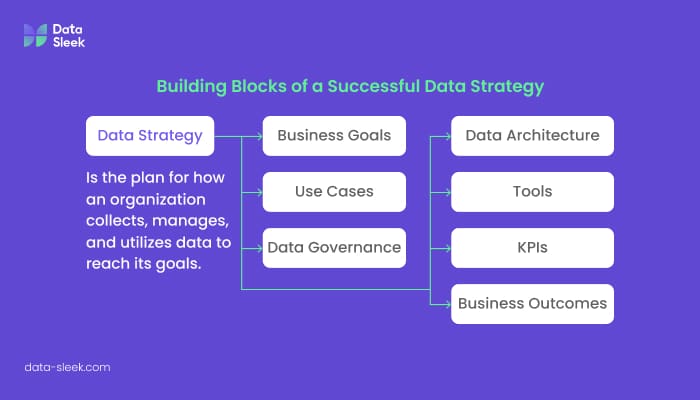
Overlooking Success and Use Rights
Failure to indicate who has access to data and under what conditions can lead to delays, internal confusion, and, at times, compliance risks. To have these access rules, an organization needs a clear data strategy, not something retrofitted into the data management process. Privacy compliance, ethical use, and operational trust all rely on upfront clarity.
Conclusion
Storing data isn’t enough anymore. In today’s AI-driven, regulation-heavy world, data strategy alignment is the blueprint that turns raw information into real business outcomes. It ensures every technical decision supports your priorities, meets compliance standards, and delivers measurable ROI.
If your organization is ready to unlock faster decisions, smarter investments, and lower risk, it’s time to move beyond tools and governance. Book a risk-free consultation with our data strategy experts today and start turning your data into a competitive advantage.
Frequently Asked Questions
Why is it a mistake to start with data warehouses or platforms before defining a data strategy?
Because without a data strategy, technology investments become guesswork. Executives risk funding expensive platforms that don’t solve real business problems. A strategy defines what outcomes matter, so tools are selected to serve a purpose, not just infrastructure goals.
How does a clear data strategy influence the success of data management initiatives?
It sets the direction. Data strategy clarifies what data is needed, how it will drive decisions, and what success looks like. Without this clarity, data management becomes reactive and misaligned, potentially wasting time, money, and resources on low-priority efforts.
What are the risks of focusing on data infrastructure and governance without aligning with business goals first?
Focusing on infrastructure and governance before understanding business objectives can slow down innovation by creating compliance roadblocks and bottlenecks. Without a strategic foundation, infrastructure and governance may lead to ineffective use of resources or misaligned data.
How can organizations ensure their data use rights are clarified before investing in data tools?
Conducting thorough audits of legal agreements and data sources can help organizations confirm what data they can legally use, monetize, or share. This prevents reputational damage, regulatory breaches, and wasted tool investments. Specifying data access rights upfront ensures any data-driven initiative is both compliant and monetizable from day one.

